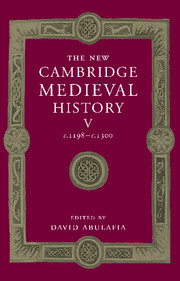Book contents
- Frontmatter
- Introduction
- Part I Common Themes
- Part II The Church in the Thirteenth Century
- Part III The Western Kingdoms
- Part IV Italy
- Part V The Mediterranean Frontiers
- Part VI The Northern and Eastern Frontiers
- 22 The Mongols and Europe
- 23 Scandinavia and the Baltic frontier
- 24 Eastern Europe
- (a) The central European kingdoms
- (b) Albania, Serbia and Bulgaria
- (c) Rus′
- 25 The Celtic lands of the British Isles
- Appendix Genealogical tables
- Primary sources and secondary works arranged by chapter
- Index
- Plate section
- Map 1 Europe in the thirteenth century
- Map 3 France, c. 1260
- Map 5 Germany and the western empire
- Map 6 Genoa, Venice and the Mediterranean
- Map 8 The Latin empire of Constantinople and its neighbours
- Map 10 Aragon and Anjouin the Mediterranean">
- References
(a) - The central European kingdoms
from 24 - Eastern Europe
Published online by Cambridge University Press: 28 March 2008
- Frontmatter
- Introduction
- Part I Common Themes
- Part II The Church in the Thirteenth Century
- Part III The Western Kingdoms
- Part IV Italy
- Part V The Mediterranean Frontiers
- Part VI The Northern and Eastern Frontiers
- 22 The Mongols and Europe
- 23 Scandinavia and the Baltic frontier
- 24 Eastern Europe
- (a) The central European kingdoms
- (b) Albania, Serbia and Bulgaria
- (c) Rus′
- 25 The Celtic lands of the British Isles
- Appendix Genealogical tables
- Primary sources and secondary works arranged by chapter
- Index
- Plate section
- Map 1 Europe in the thirteenth century
- Map 3 France, c. 1260
- Map 5 Germany and the western empire
- Map 6 Genoa, Venice and the Mediterranean
- Map 8 The Latin empire of Constantinople and its neighbours
- Map 10 Aragon and Anjouin the Mediterranean">
- References
Summary
AMONG the Pannonians, therefore, three brothers were born to Pan, prince of the Pannonians. The first was named Lech, the second Rus and the third Czech. These three held the three kingdoms of the Lechites [Poles], Russians and Czechs (or Bohemians)… ‘Germo’ is a type of vehicle in which two oxen are yoked together to draw a plough or pull a cart, and so the Germans and the Slavs, having common borders, pull together; there is no people in the world so familiar and friendly to one another as the Slavs and Germans … We should not forget the Hungarians, who also are Slavs, named after a river called the Wkra.
The mythical common descent of the founding fathers of the Slavonic nations, expounded here by the Chronicle of Greater Poland, composed around 1295, reflects an idea of a community of central European realms, which was informed by various relationships between Poland, Bohemia, (south-western) Rus′ and (non-Slavonic) Hungary throughout the central and later Middle Ages. Legendary unity became brief reality when Vaclav III of Bohemia (1305) was also king of Hungary (1301) and Poland (1306). In the fifteenth and sixteenth centuries the Lithuano-Polish house of Jogaila (Jagiełło) would achieve a similar, and slightly less fragile, dynastic hegemony. The image of Germanic and Slavonic oxen ploughing a common furrow is particularly appropriate to a world where farmers, artisans and clergy from north-western Christendom and the empire settled on a considerable scale throughout central Europe.
- Type
- Chapter
- Information
- The New Cambridge Medieval History , pp. 754 - 778Publisher: Cambridge University PressPrint publication year: 1999

